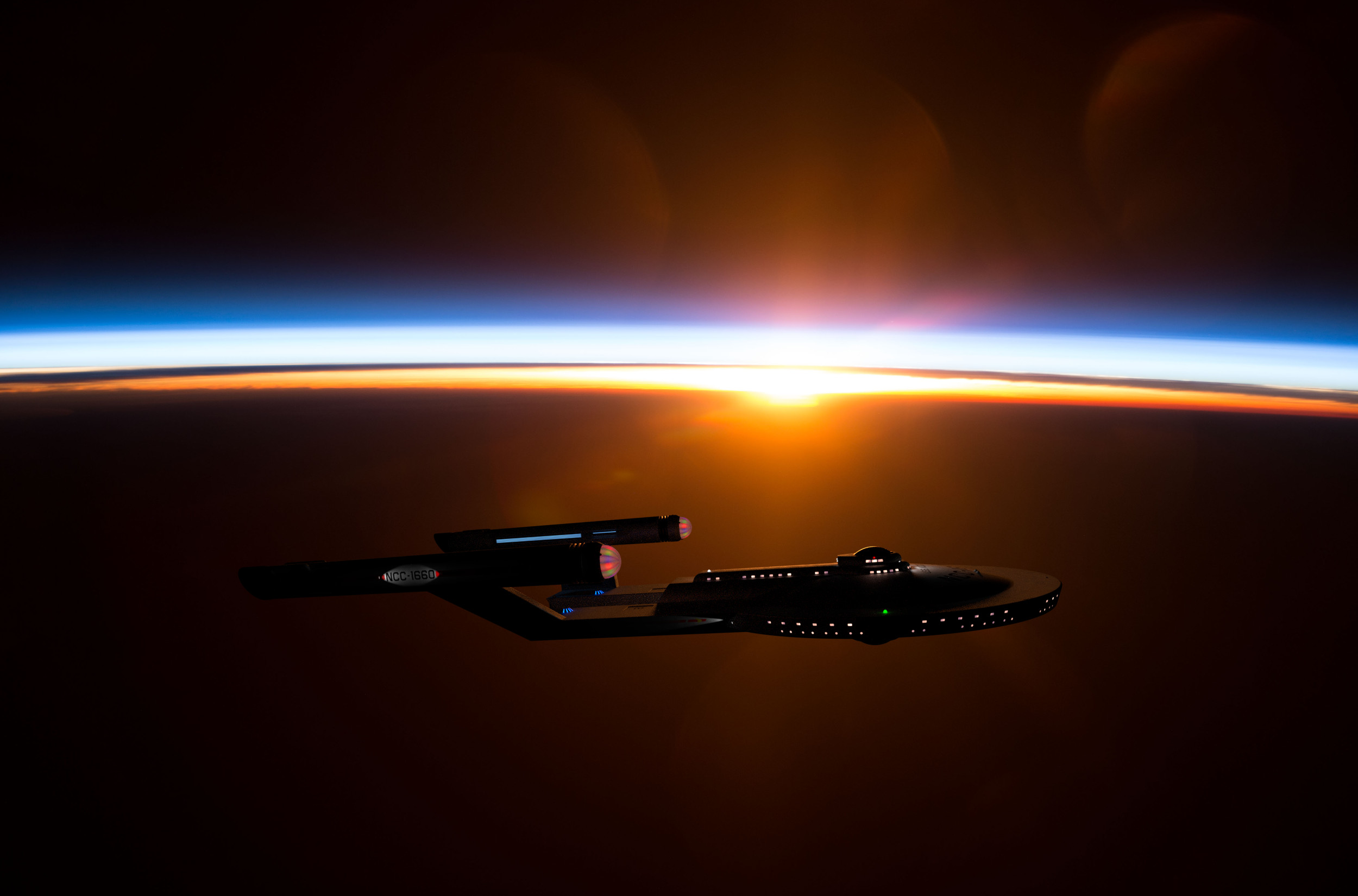Nicely done
-
Welcome! The TrekBBS is the number one place to chat about Star Trek with like-minded fans.
If you are not already a member then please register an account and join in the discussion!
You are using an out of date browser. It may not display this or other websites correctly.
You should upgrade or use an alternative browser.
You should upgrade or use an alternative browser.
Ship Vectors & Other Such Things
- Thread starter The Librarian
- Start date
Hey... Can you give use a shot of the Corona bridge with Show Hidden Geometry enabled? I'm curious as to how many segments there are in that curve...
Here you go, from the Sketchup file and the raw .obj. I'm not sure how many faces etc there are, because I can't figure out how to make any of these programs spit that out.
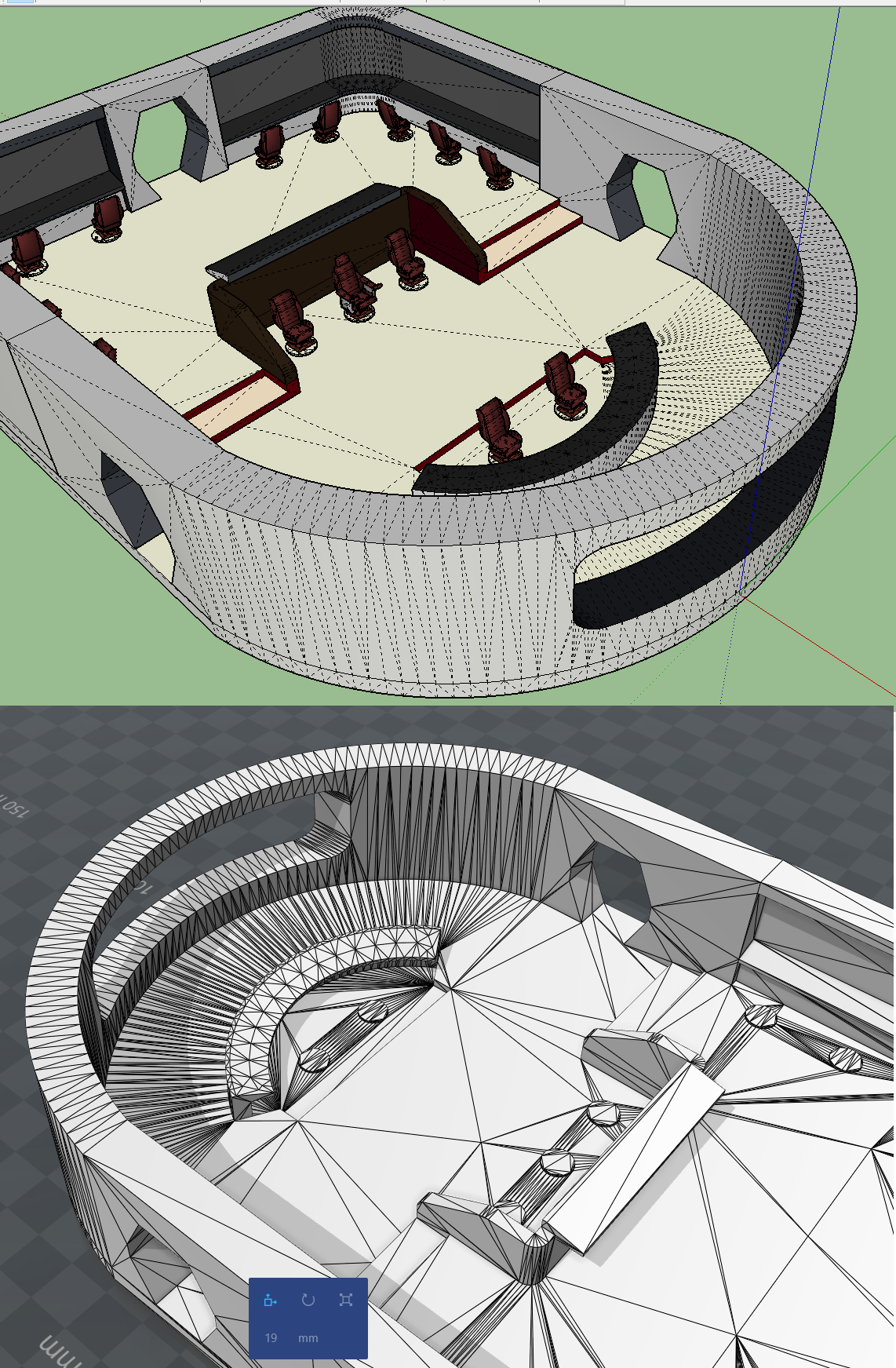
Hmmm... Normally when you select a curve that's made in SketchUp, the Entity Info window will give you the segment count. Seeing as this is imported, that won't work. Every edge is a single entity instead of behaving like one whole curve; a downside of importing stuff into SketchUp.
Revised the Mercury a bit. Call it a Block B version. The nacelles use a more complicated loft shape, tapered to reflect the Discovery and slightly longer because in perspective they ended up looking stubby at the original length. There's also a change to the saucer rim to make it more unique and adjust the window height and spacing to match internal deck layout. With more info on Discovery it seems like I may have overshot the size of the saucer but it's still smaller than the Kelvin, more or less.

I updated the 3d mockup too. Still very simple and windowless but it shows how the shapes come together in perspective.
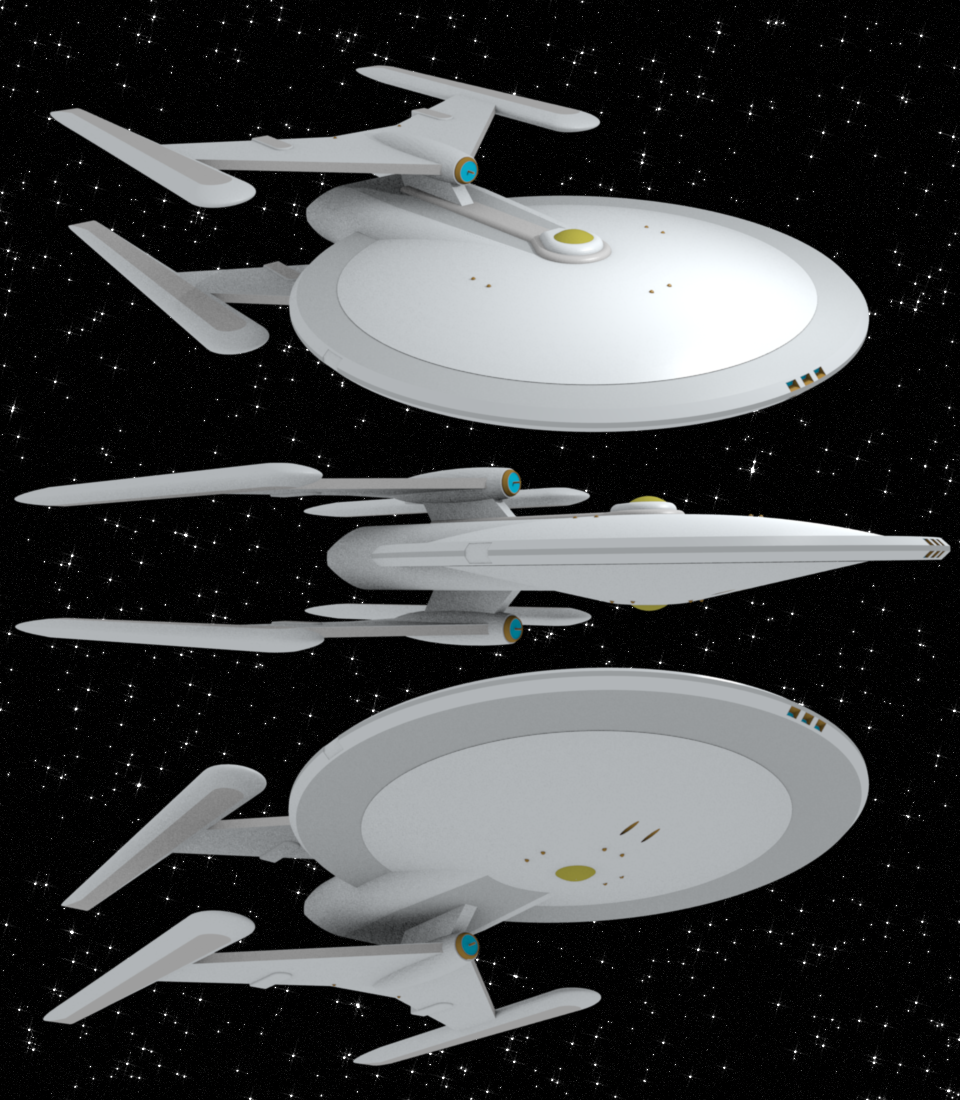

I updated the 3d mockup too. Still very simple and windowless but it shows how the shapes come together in perspective.

Indeed the longer new nacelles look a lot better, though maybe a little bit too flat in my opinion.
Yeah, I agree that they're too plain at the moment. Probably needs some intercoolers or fins on the outside surfaces, and maybe a TOS-style indent on the inner side.
First off is a four-nacelle ship. It is roughly Ambassador-ish in the timeline, certainly in the 'Lost Era'.
USS Hornet
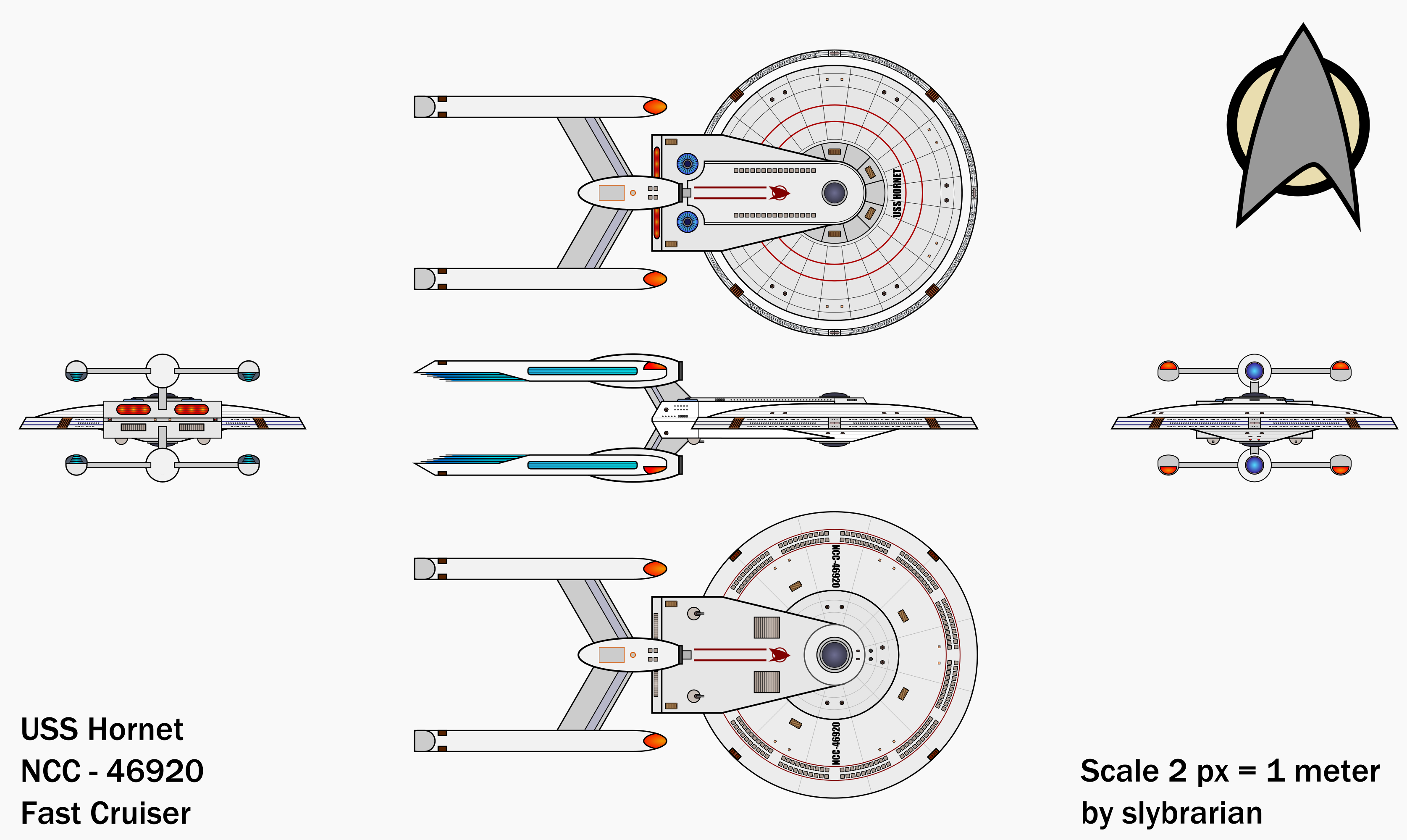
The Hornet is a fast cruiser, designed so that it can cruise on just one set of nacelles or sprint on both. Essentially it acts as a rapid response ship. The primary hull is as large as that of the Ambassador - slightly larger, really, with the rear superstructure - and it has a pair of engineering hulls, each with a warp core. It has a fairly large crew and room to take on mission specialists as needed. There are a pair of big shuttle bays, and another pair of cargo bays below them that can be converted to additional shuttle or dropship bays. There's also a couple Constellation-style external turrets, in this case carrying tractor beams to haul derelicts or prefab base modules.
The phasers are midway between movie-era ball turrets and Ambassador-era phaser strips, basically having multiple emitter segments on each bank. There are a pair of torpedo tubes at the bottom of the saucer, Constitution-style, plus two more at the rear.
Length: 600 meters
Beam: 340 meters
Height: 174 meters
Decks: 35
Cruise Speed: Warp 9
Maximum Speed: Warp 9.4
Emergency Speed: Warp 9.98 (24 hours)
Armament:
10x Type-10 Twin Facet-Point Phaser Banks
20x Type-5 Phaser Defense Turrets (experimental upgrade)
4x Photon Torpedo Tubes / 3-round burst capacity
Core Crew: 1,000
Mission Specialists / Passengers: 400
Emergency Maximum: 5000
Small Craft:
20x Shuttlecraft (Type-7 or Type-8)
2x Danube-class Runabouts
Dropships (If Cargobays Converted): 6x Hoppers or Scoutships, or 12x Light Fighters
Produced Vessels:
USS Hornet
USS Wasp
USS Ranger
USS Shangri-La
My overall aesthetic impression of the Starship Hornet, FWIW...
It looks infinitely better and far more logical (for a four-nacelle, one-major hull craft) than the Constellation-class Stargazer.
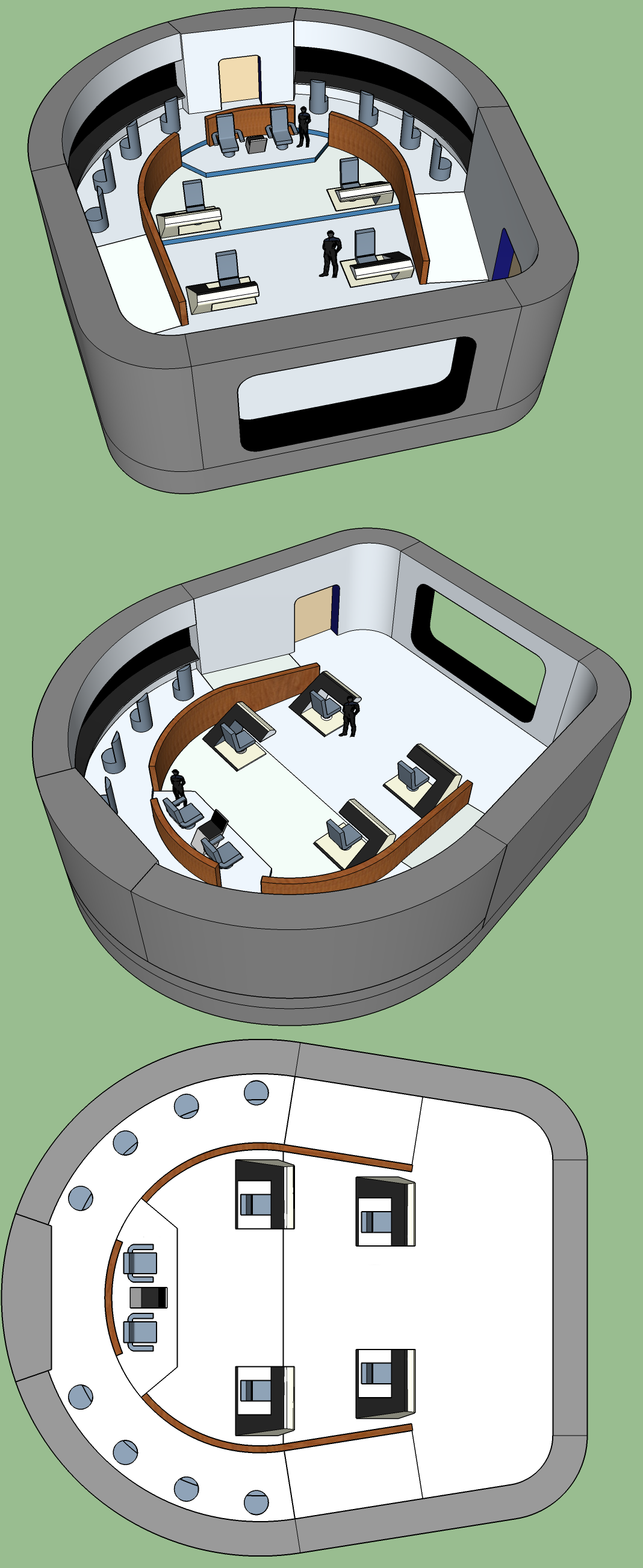
Here's a more TNG-styled bridge. It uses the same sort of layout philosophy, with the main stations in the central area where they're in front of the captain, and the less important work stations out on the perimeter where they won't be distracting but are still available if needed. Originally I had the XO sitting at the right-hand middle station, but it seemed too far and there was space next to the captain, so now they're at the CO's right hand and the other station is for either a mission specialist or science officer. Colors would probably be chosen to complement the wooden rail.
And now for a few WIPs. It's a late 24th century cruiser, tentatively named 'Pulsar'. One of a few I'm playing around with, in this case in the style of a Miranda, Akira, or from many angles the Shenzhou. Windows, escape pods, and other details will be added as I flesh out the interior. About 500 meters long. The nacelles are placeholders until I figure out a good way to represent something fancier like the Sovereign or Vesta class uses.

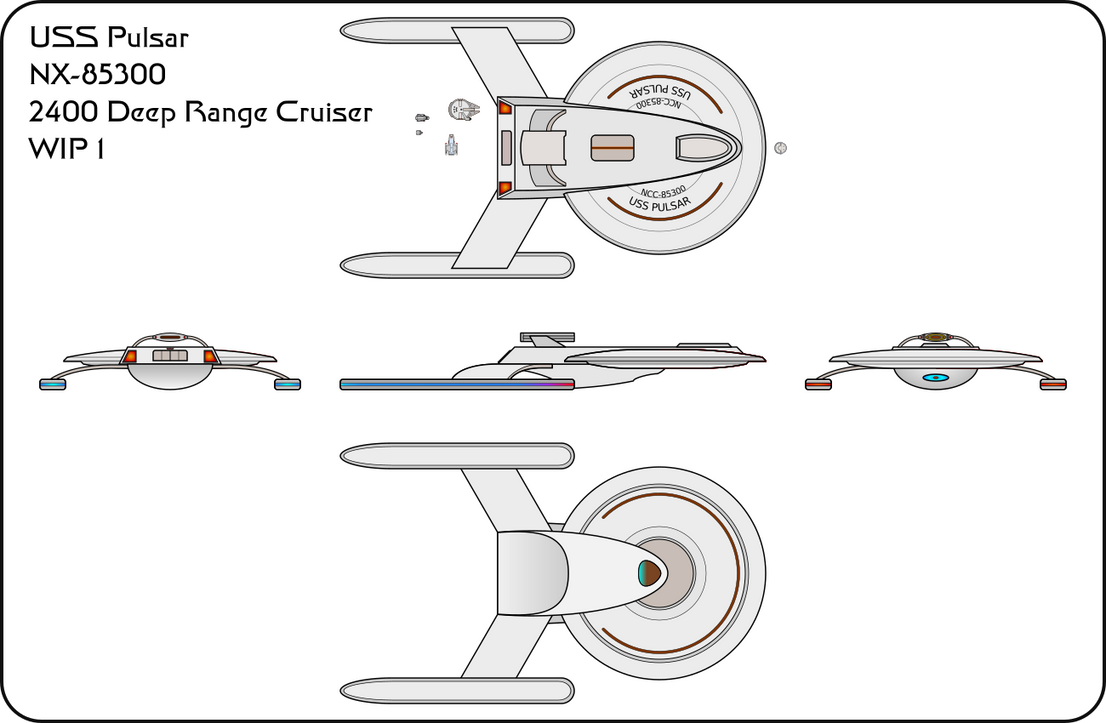
Originally this was going to be a bigger, traditional styled ship (now called 'Magnetar') but I was having trouble getting the neck to look right and slimmed it down. I may come back to it.
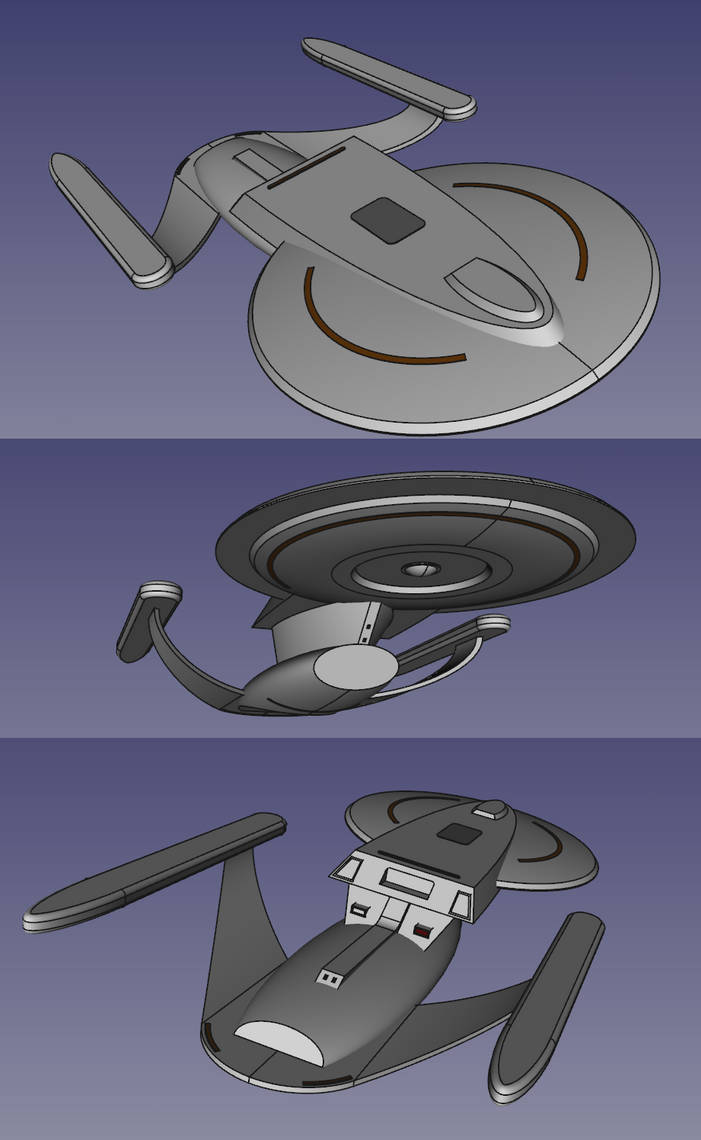


Originally this was going to be a bigger, traditional styled ship (now called 'Magnetar') but I was having trouble getting the neck to look right and slimmed it down. I may come back to it.

Nicely done Looking forward to seeing more
An update with the exterior details mostly complete, save some things like panel lines, shading, and maybe an attempt at aztecing. Most of the changes are unnoticeable, like a slightly deeper belly section and moving the pod forward a bit, except for the new nacelles. Getting the perspective right on the lounge windows was a pain.
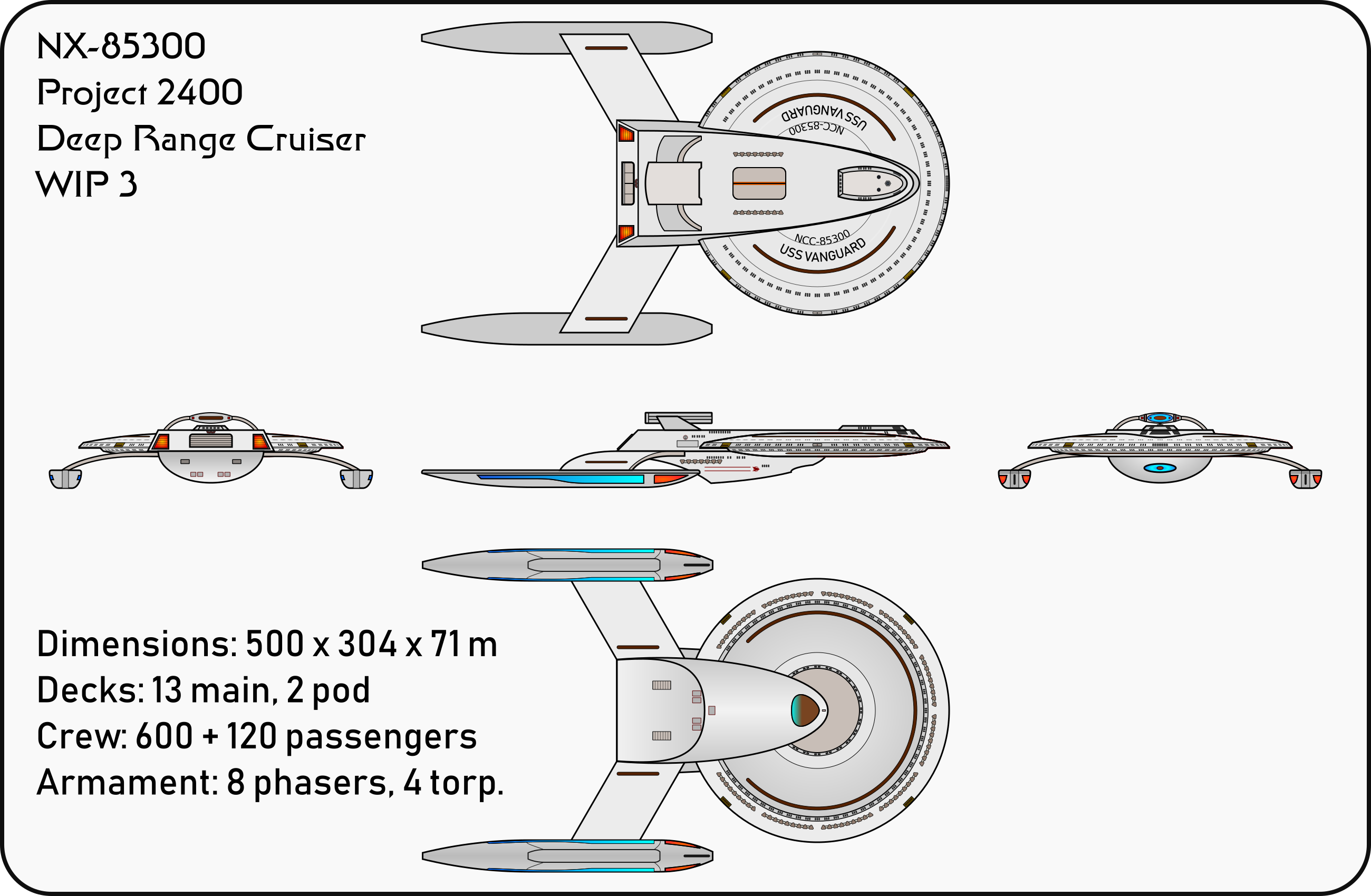
Here's a basic idea for the bridge, with somewhat high contrast colors. A fairly late-TNG and quasi-Sovereign layout, very angular mostly due to the tools I'm working with.
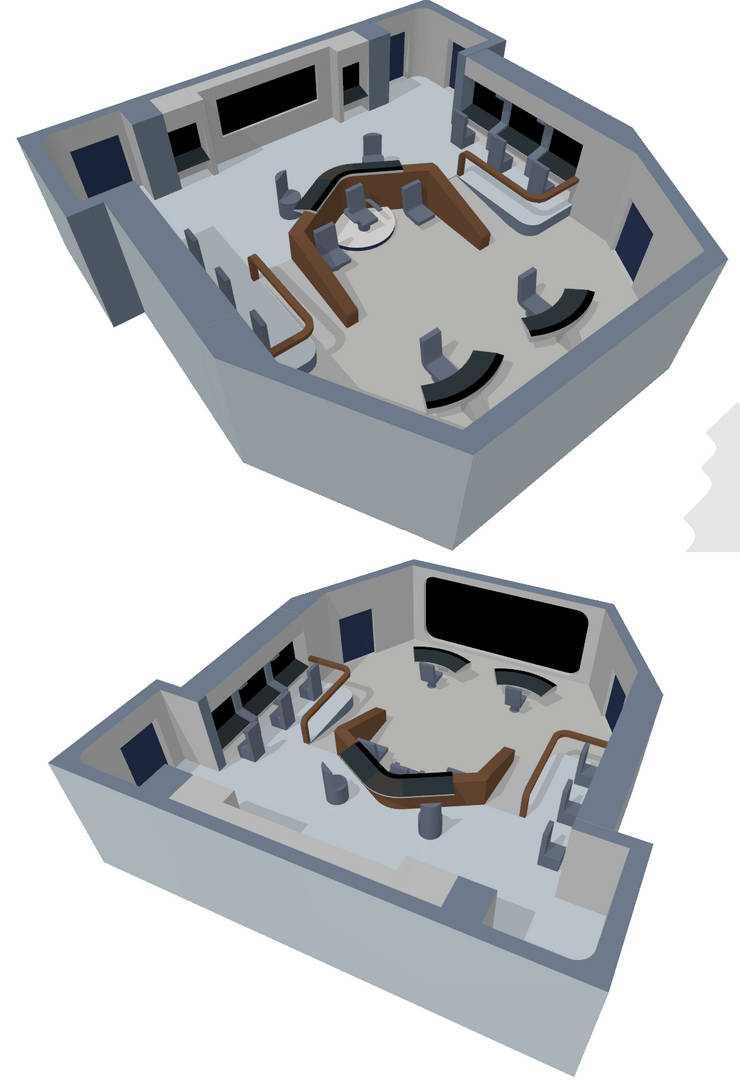

Here's a basic idea for the bridge, with somewhat high contrast colors. A fairly late-TNG and quasi-Sovereign layout, very angular mostly due to the tools I'm working with.

A comparison chart of my ships next to the canon hero ships of similar eras:

My 24th-century cruiser actually ended up very similar in size to the Akira, more or less by accident. In fact it's just slightly larger in volume according to the rough volumetric calculation I did.

My 24th-century cruiser actually ended up very similar in size to the Akira, more or less by accident. In fact it's just slightly larger in volume according to the rough volumetric calculation I did.
Nicely done
Working on another new ship, this one a roughly Ambassador or Sovereign-sized cruiser from the mid 2360s. The major exterior features are in but I'm working on some of the internal spacing to figure out where to put escape pods, windows, etc.




Something a little different that happened as part of other projects and the need for a an attack ship that could actually fit in a shuttle bay.

Crew: 1
Length: 9 meters
Width: 9 meters (wings extended) / 5.5 meters (wings folded)
Top Speed: Warp 4
Primary Armament: 4x Type-5 phaser arrays
External Mission Pods Options:
Type-5c Pulse Phaser Cannon
Standard Photon Torpedo
Microtorpedo Swarm (10-tube)
Experimental Short-Range Missile (6-tube)
Electronic Warfare / Long-Range Sensor Package
The Type X6F Light Fighter is an experimental class of light support fighter developed after the Dominion War, in response to a desire to provide more options for tactical-focused support craft for smaller starships, stations, and outposts or colonies. The design is intended to be easily manufactured using onboard resources found on most ships capable of long-term deployment, and more importantly fit into their shuttlebays without requiring significant loss of other launch and recovery capability.
During the war, Starfleet fielded two official types of fighter craft. The first was the PT-series of single-person fighters. These craft were light and nimble, mounting three Type-4 phasers and a pair of micro-munitions launchers. They were designed primarily to serve in ground attack roles, supporting troops in situations where direct starship support was impractical due to defensive screens or electronic countermeasures. If needed, they could serve as close defense ships in space, but their limited flight duration, small power plants, and impulse-only design made them unsuited for any serious combat against major threat vessels. At the time they were designed, this was seen as acceptable, as many threat force polities had sufficiently accurate beam weapons that an attack on a major capital ship by fighters was viewed as a waste of lives and resources.
In space, the more common fighter was the Peregrine-class. Originally developed as a small courier ship in the 2340s, the Maquis acquired several dozen and converted them into makeshift attack ships. Starfleet Tactical analyzed their performance against the Cardassians and developed an official upgrade package, which was deployed throughout the entire fleet and auxiliary planetary defense forces. These upgrades included both full and micro-torpedoes, a Type-5 beam phaser for precision attack, and pulse phasers for anti-starship work. Peregrines became a common sight in major fleet engagements, providing screening for capital ships against enemy attack vessels, and were even more widely deployed for defense of smaller colonies against both Dominion raids and opportunistic pirates in rear areas. Independent warp capability meant they could largely self-deploy for short journeys, but their large size meant they could not land in anything but the largest bays, generally found on ships like the Galaxy- and Nebula-classes or dedicated carriers. Even the famous Akira-class could just barely fit a handful inside, instead mostly using PT-series fighters.
With these limitations in mind, some enterprising starship crews developed a smaller alternative, dubbed the Type-9F tactical shuttle. Built on the hull on a standard Type-9, the rear cargo compartment was closed off and filled with an additional fusion generator and shield system. Two external pylons were added atop the nacelle supports to allow mounting of either photon torpedoes, canisters of runabout-class micro torpedoes, or pulse phasers. While often cantankerous and maintenance-heavy, these upgraded shuttles had enough shields and weapons to threaten Cardassian and Jem'hadar attack ships in numbers, and provided valuable support for ships or small squadrons unable to launch proper attack fighters. This allowed their motherships to focus on larger threat vessels that the fighters couldn't effectively damage.
Seeing the relative success of this design, Starfleet Tactical developed several prototype projects to create a more optimized design that could fill this need. The X6F 'Hellcat' was one of several competing options sent out for field testing. In terms of size, it was specifically designed to fit into a standard Class Two shuttle maintenance slot, and uses enough common parts from other shuttles to simplify repairs and logistics. Integrated warp nacelles provide ample intrasystem flight capability and limited interstellar travel. Four built-in phasers are the core of the offensive capabilities, allowing accurate strikes against ground targets or vital systems, as well as defense against similarly-sized craft.
The key feature to make the Hellcat stand out was the external pylons for mission-specific pods. Originally intended to allow the fighter to carry photon torpedoes, it ultimately proved easier to move the desired microtorpedo launchers to them as well. There is considerable debate at Starfleet Tactical about whether a single standard torpedo, going slower than usual due to launch of a proper launch system, would be better replaced with a swarm of microtorps, which not only would have better range but could carry several reload volleys. These would also provide more viable ground attack options, allowing the retirement of the PT-series in favor of a single multi-role craft. A third proposed option was a new class of short-range photonic missile derived from Voyager reports relayed by Project Pathfinder. These options are also supplemented by designed pods for pulse phasers, electronic warfare / sensor packages, and fuel tanks. Crews are encouraged to experiment with additional mission options.
(Developed because I needed something that would fit in reasonable numbers inside a typical starship, which the Peregrine most certainly will not. Neither will X-Wings either for the most part; this is roughly the size of an A-Wing or a Viper. Originally I was working on the mentioned Type-9 fighter but it was way to much of a chunky boy to look good fighter-ish.)

Crew: 1
Length: 9 meters
Width: 9 meters (wings extended) / 5.5 meters (wings folded)
Top Speed: Warp 4
Primary Armament: 4x Type-5 phaser arrays
External Mission Pods Options:
Type-5c Pulse Phaser Cannon
Standard Photon Torpedo
Microtorpedo Swarm (10-tube)
Experimental Short-Range Missile (6-tube)
Electronic Warfare / Long-Range Sensor Package
The Type X6F Light Fighter is an experimental class of light support fighter developed after the Dominion War, in response to a desire to provide more options for tactical-focused support craft for smaller starships, stations, and outposts or colonies. The design is intended to be easily manufactured using onboard resources found on most ships capable of long-term deployment, and more importantly fit into their shuttlebays without requiring significant loss of other launch and recovery capability.
During the war, Starfleet fielded two official types of fighter craft. The first was the PT-series of single-person fighters. These craft were light and nimble, mounting three Type-4 phasers and a pair of micro-munitions launchers. They were designed primarily to serve in ground attack roles, supporting troops in situations where direct starship support was impractical due to defensive screens or electronic countermeasures. If needed, they could serve as close defense ships in space, but their limited flight duration, small power plants, and impulse-only design made them unsuited for any serious combat against major threat vessels. At the time they were designed, this was seen as acceptable, as many threat force polities had sufficiently accurate beam weapons that an attack on a major capital ship by fighters was viewed as a waste of lives and resources.
In space, the more common fighter was the Peregrine-class. Originally developed as a small courier ship in the 2340s, the Maquis acquired several dozen and converted them into makeshift attack ships. Starfleet Tactical analyzed their performance against the Cardassians and developed an official upgrade package, which was deployed throughout the entire fleet and auxiliary planetary defense forces. These upgrades included both full and micro-torpedoes, a Type-5 beam phaser for precision attack, and pulse phasers for anti-starship work. Peregrines became a common sight in major fleet engagements, providing screening for capital ships against enemy attack vessels, and were even more widely deployed for defense of smaller colonies against both Dominion raids and opportunistic pirates in rear areas. Independent warp capability meant they could largely self-deploy for short journeys, but their large size meant they could not land in anything but the largest bays, generally found on ships like the Galaxy- and Nebula-classes or dedicated carriers. Even the famous Akira-class could just barely fit a handful inside, instead mostly using PT-series fighters.
With these limitations in mind, some enterprising starship crews developed a smaller alternative, dubbed the Type-9F tactical shuttle. Built on the hull on a standard Type-9, the rear cargo compartment was closed off and filled with an additional fusion generator and shield system. Two external pylons were added atop the nacelle supports to allow mounting of either photon torpedoes, canisters of runabout-class micro torpedoes, or pulse phasers. While often cantankerous and maintenance-heavy, these upgraded shuttles had enough shields and weapons to threaten Cardassian and Jem'hadar attack ships in numbers, and provided valuable support for ships or small squadrons unable to launch proper attack fighters. This allowed their motherships to focus on larger threat vessels that the fighters couldn't effectively damage.
Seeing the relative success of this design, Starfleet Tactical developed several prototype projects to create a more optimized design that could fill this need. The X6F 'Hellcat' was one of several competing options sent out for field testing. In terms of size, it was specifically designed to fit into a standard Class Two shuttle maintenance slot, and uses enough common parts from other shuttles to simplify repairs and logistics. Integrated warp nacelles provide ample intrasystem flight capability and limited interstellar travel. Four built-in phasers are the core of the offensive capabilities, allowing accurate strikes against ground targets or vital systems, as well as defense against similarly-sized craft.
The key feature to make the Hellcat stand out was the external pylons for mission-specific pods. Originally intended to allow the fighter to carry photon torpedoes, it ultimately proved easier to move the desired microtorpedo launchers to them as well. There is considerable debate at Starfleet Tactical about whether a single standard torpedo, going slower than usual due to launch of a proper launch system, would be better replaced with a swarm of microtorps, which not only would have better range but could carry several reload volleys. These would also provide more viable ground attack options, allowing the retirement of the PT-series in favor of a single multi-role craft. A third proposed option was a new class of short-range photonic missile derived from Voyager reports relayed by Project Pathfinder. These options are also supplemented by designed pods for pulse phasers, electronic warfare / sensor packages, and fuel tanks. Crews are encouraged to experiment with additional mission options.
(Developed because I needed something that would fit in reasonable numbers inside a typical starship, which the Peregrine most certainly will not. Neither will X-Wings either for the most part; this is roughly the size of an A-Wing or a Viper. Originally I was working on the mentioned Type-9 fighter but it was way to much of a chunky boy to look good fighter-ish.)
Similar threads
Contest: ENTER
January 2026 Art Challenge - Suggest Your Themes!
- Replies
- 2
- Views
- 277
Contest: ENTER
November 2025 Art Challenge - Suggest Your Themes!
- Replies
- 3
- Views
- 667
- Replies
- 7
- Views
- 692
If you are not already a member then please register an account and join in the discussion!

